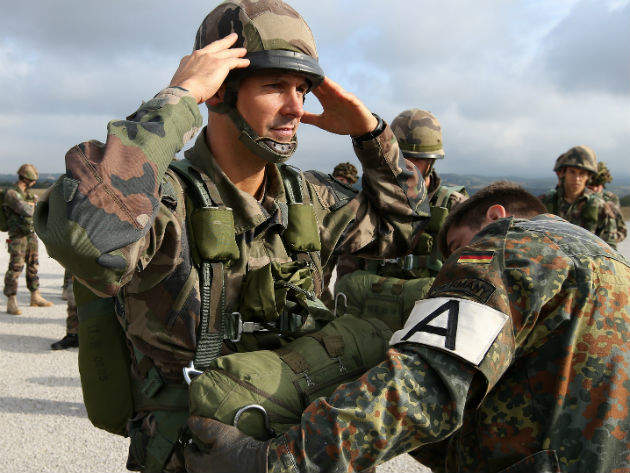

“The past years have shown that we must not take the achievements of the European post-war order for granted,” Chancellor Angela Merkel wrote in her introduction to the paper. “We would not have believed it possible that borders would be redrawn by military force and in breach of international law in Europe in the 21st century. Wars and conflicts are raging on Europe’s doorstep.”
A number of issues borne of this growing instability now pose a threat to Germany’s security: the migrant crises and resulting quick growth in Germany’s population, Islamist terrorism, the cyber challenge, and the shift in relationships with international partners, namely Russia, which is “rejecting a close partnership with the West and placing emphasis on strategic rivalry… presenting itself as an independent power centre with global ambitions,” according to the white paper.
Stronger together
Germany’s security is based on partnerships – a strong North Atlantic Alliance in NATO and a united European Union are fundamental to the nation’s security policy. In order to maintain and grow these partnerships – and take a more leading role within them – the white paper identifies a number of areas where this policy can be shaped to better suit the wider, less stable global context that Germany faces as it looks toward the third decade of the 21st century and beyond.
The white paper heralds a more active Germany that recognises the need to be more proactive in its own defence and that of its allies. Many welcome this change in tone. Since its reunification Germany has continued to be hesitant about the use of its military power, particularly in securing its own interests.
Mostly it has worked within the framework of the NATO alliance where there has been real need, such as in Kosovo and later in Afghanistan. It was also vehemently against the US invasion of Iraq – a position that in hindsight seems to have been correct. However, as security on the continent has worsened the German public has finally been convinced of the need for a more active defence policy.
How well do you really know your competitors?
Access the most comprehensive Company Profiles on the market, powered by GlobalData. Save hours of research. Gain competitive edge.

Thank you!
Your download email will arrive shortly
Not ready to buy yet? Download a free sample
We are confident about the unique quality of our Company Profiles. However, we want you to make the most beneficial decision for your business, so we offer a free sample that you can download by submitting the below form
By GlobalDataMore and better equipped soldiers
Key to this is an expansion of the country’s land forces, with plans to recruit nearly 14,300 soldiers over the next seven years in order to update the task spectrum of the Bundeswehr and meet the growing demands placed on it by military commitments and the increased expectations of its allies and partners.
Critically, a deeper pool of personnel will enable the German Army to improve its defence posture in the face of the changing character of conventional and collective defence that relies increasingly on short-notice deployments to face spatially focused threats. With operations no longer necessarily conducted in large contingents the army must be ready to “deliver effects across the entire operational spectrum and ensure that it is ready and capable,” as the white paper pointed out.
In doing so, the paper suggests that Germany will be more formally prepared to take a stronger role in military engagements outside NATO territory, loosening its previously firm stance that its military engagement outside NATO territory should be covered when possible by a UN Security Council mandate and take place in a NATO or EU framework.
In its July 2016 commentary on Germany’s new security strategy, the Centre for Strategic and International Studies (CSIS) pointed out that “Germany is participating, for example, in the US-led counter-ISIL coalition alongside European allies and partners in the region, with approval of the Bundestag. The white paper accepts the principle of ad hoc coalitions as a legitimate form of German military engagement. This endorsement in Germany’s highest strategy document ensures that Germany will be able to consider participation in other coalitions in the future as a matter of efficacy, not as a precedent-breaking example.”
A boost for Germany’s under-funded forces
The recruitment drive will be underpinned by an increased defence budget with an extra €5bn being added to the pot – from €34.2bn to €39.2bn by the end of the 2020s.
However, there is a lot to be done with this new and improved budget. The last few years have seen a number of reports leaked that show the extent to which Germany’s armed forces have been undermined by political neglect, budget cuts, equipment issues, and on-going programme overruns and cost blow outs.
A 2014 leaked parliamentary report published by the Washington Post showed a military force running on empty: three out of its four submarines are out of service, less than 40% of its Boxer armoured personnel carrier and infantry fighting vehicles are fit for operations, and only seven of the navy’s 42-strong fleet of NH90 tactical transport helicopters are flightworthy.
Germany’s NH90 programme is a prime example of the difficulties the military has faced in trying to arm its forces with world-class equipment while managing a budget in decline. The programme was initiated in the late 1980s, with the helicopter designed as a common helicopter with different variants for NATO requirements.
From its first flight in 1995 and delivery to German forces in 2006, the programme limped through delay after delay, including the loss of an aircraft in Uzbekistan in 2014 and the grounding of the entire fleet. The army was originally expected to order around 200 aircraft, but will end up with a fleet of only around 82 aircraft by the time deliveries complete in 2021.
Is it enough?
Beyond such equipment considerations, commentators question whether the white paper goes far enough. It sets out a vision for Germany’s defence in the future, but there are few concrete proposals of how to reach that state.
In addition, although the extra funds are welcome, it still leaves German defence spending well below the 2% threshold considered adequate by NATO and once you dig deeper in to the figures, spending on new equipment also falls short of the 20% figure usually quoted as sufficient for a NATO nation.
Although the white paper sets out the ideal of a new, more active German defence policy, it will prove a long hard march for the army and its sister services to shape themselves to the future.






